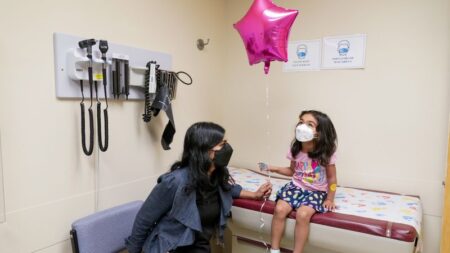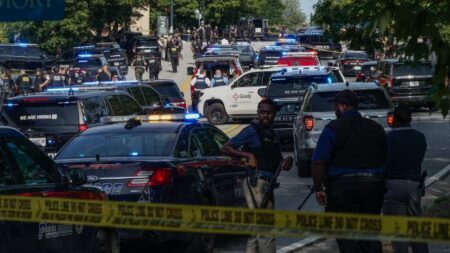Dr. Christina Johns, a pediatric emergency medicine physician, has worked at Children’s National Hospital in Washington, D.C., where she encountered numerous traumatic cases, but one particular incident remains etched in her memory: the arrival of a two-year-old child suffering from a gunshot wound to the chest. The case was severe, and the urgency was palpable with an estimated time of arrival in just five minutes. This tragic event occurred when the toddler was accidentally shot by an older sibling, highlighting the dangers that unsecured firearms pose in households.
Johns vividly recalls the scene: “I’ll never forget the sight of the child on the stretcher and the heart-wrenching screams of the parent outside the room.” This incident shines a light on a disturbing trend; according to a recent analysis published by researchers from the US Centers for Disease Control and Prevention (CDC), an emergency department treats a firearm injury approximately every 30 minutes in the US. This data underscores the pressing nature of firearm-related incidents, particularly among children.
The necessity for comprehensive research into firearm injuries is apparent, yet proposed cuts from the US Department of Health and Human Services and alterations to the federal budget pose a significant threat to such investigations. Experts express concern over the possibility of losing valuable insights into firearm injury trends if federal backing diminishes, arguing that replicating the breadth and depth of federally conducted research could become nearly unachievable.
A recent study published in the Annals of Internal Medicine has contributed important findings regarding the patterns of firearm injuries. It indicates that emergency department visits for such injuries are not evenly spread across time; rather, they peak during late-night hours, on weekends, and during specific holidays such as Independence Day and New Year’s Eve. This data is critical as it can influence emergency room staffing and resource allocation, ultimately improving care for patients facing firearm-related injuries.
Dr. Johns attributes the survival of the young gunshot victim to the comprehensive preparation and immediate response from the medical staff at their Level 1 trauma center. The child’s treatment involved an impressive cadre of roughly 15 healthcare professionals, each playing vital roles including doctors, nurses, and additional support staff prepared for an emergency. “Trauma care takes a village,” emphasized Dr. Katherine Hoops, who runs the Clinical Programs and Practice Team at the Johns Hopkins Bloomberg School of Public Health’s Center for Gun Violence Solutions, underscoring the importance of a well-rounded team including mental health professionals and social workers in such crisis situations.
It is alarming that firearm injuries have become the leading cause of death among children and teenagers in the United States. Emergency medical encounters for firearm injuries surged in 2021 and remain above pre-pandemic levels. Simultaneously, firearm suicides have reached alarming rates, marking a troubling peak not seen in the last five decades. According to the CDC, the study in question analyzed more than 93,000 emergency department visits concerning firearm injuries, utilizing data from various states including Florida, North Carolina, and Oregon between 2018 and 2023.
The analysis revealed that gunshot wound patients most frequently arrived at emergency departments between the hours of 2:30 and 3 a.m., as opposed to a notable lull in cases around 10 to 10:30 a.m. Highlighting patterns further, it showed that the highest rates of cases occurred from late Friday to Saturday and Saturday to Sunday, with July exhibiting the overall highest case rates and February showing the lowest.
Despite the revelation of these patterns, challenges remain. Even if emergency departments might have adequate staff during off-peak hours, other hospital resources may still be limited during nighttime and weekends, creating potential hurdles in urgent care scenarios. Experts underscore the necessity for ongoing emergency department staffing and preparedness, as variations from these observed patterns can and do occur.
The operation of the FASTER program—an initiative led by the CDC’s National Center for Injury Prevention and Control—has increasingly come under scrutiny. With more than 40 health organizations calling for the reinstatement of the center following recent federal cutbacks, the future of firearm injury research hangs in the balance. The coalition seeks to maintain the pivotal role that such data plays in shaping injury and violence prevention policies at various government levels.
While it has been stated that the FASTER program continues to operate, apprehensions persist concerning the potential inadequacy of the team to analyze, interpret, and leverage the collected data effectively due to staff reductions. Historical constraints, such as those instantiated by the Dickey Amendment, which prevented the utilization of federal funds for research promoting gun control, have further complicated the landscape of firearm research.
As the national discourse on firearms evolves, the imperative for comprehensive, collaborative research into the causes and consequences of firearm injuries remains critical. Failure to prioritize these inquiries could signal an even deeper descent into uncharted territories of gun violence. Such a regression would undermine efforts taken in recent years to build a more informed, multilateral approach to this pervasive issue.












